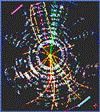Department of Physics and Astronomy: Publications and Other Research

Kenneth Bloom Publications
Document Type
Article
Date of this Version
July 2008
Abstract
We present first evidence for the production of single top quarks in the D0 detector at the Fermilab Tevatron pp collider. The standard model predicts that the electroweak interaction can produce a top quark together with an anti-bottom quark or light quark, without the antiparticle top-quark partner that is always produced from strong-coupling processes. Top quarks were first observed in pair production in 1995, and since then, single top-quark production has been searched for in ever larger data sets. In this analysis, we select events from a 0.9 fb-1 data set that have an electron or muon and missing transverse energy from the decay of a W boson from the top-quark decay, and two, three, or four jets, with one or two of the jets identified as originating from a b hadron decay. The selected events are mostly backgrounds such as W + jets and tt events, which we separate from the expected signals using three multivariate analysis techniques: boosted decision trees, Bayesian neural networks, and matrix-element calculations. A binned likelihood fit of the signal cross section plus background to the data from the combination of the results from the three analysis methods gives a cross section for single top-quark production of σ(pp Y→ tb + X, tqb + X) = 4.7 ± 1:3 pb. The probability to measure a cross section at this value or higher in the absence of signal is 0.014%, corresponding to a 3.6 standard deviation significance. The measured cross section value is compatible at the 10% level with the standard model prediction for electroweak top-quark production. We use the cross section measurement to directly determine the Cabibbo-Kobayashi- Maskawa quark mixing matrix element that describes the Wtb coupling and find |VtbƒL1 | = 1.31-0.21+0.25 , where ƒL1 is a generic vector coupling. This model-independent measurement translates into 0.68 < |Vtb| ≤ 1 at the 95% C.L. in the standard model.


Comments
Published in Physical Review D 78, 012005 (2008).